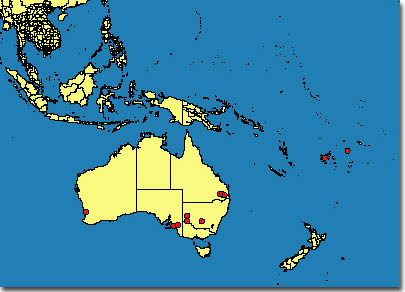

 |
 |
||
|
|
|||
| Diagnosis | Encarsia formosa (Gahan) |
|||||||||||||
| Species group | ||||||||||||||
| Distribution | ||||||||||||||
| Host | ||||||||||||||
| Comments | ||||||||||||||
| Illustrations | ||||||||||||||
| DNA | ||||||||||||||
Encarsia formosa Gahan, 1924: 14. Syntypes female. USA, Idaho, Twin Falls (USNM). Encarsia formosa: Ferriére ,1965: 137; Nikol'skaya & Yasnosh, 1966: 266; Viggiani & Mazzone, 1979: 45; Huldén, 1986: 18; Rivnay & Gerling, 1987: 465; Viggiani, 1987b: 144; Liao et al., 1987: 151; Jiang & Petzold, 1988: 494; Yasnosh, 1989: 110; Polaszek et al., 1992: 382; Viggiani & Ren, 1993: 226; Liu & Stansly, 1996: 386; Huang & Polaszek, 1998: 1881; Polaszek et al., 1999: 146. |
||||||||||||||
Diagnosis |
FemaleColourHead and mesosoma brown, contrasting with yellow remainder of body. Gaster yellow except brown at base. Antenna yellow, petiole and antennal tip slightly darker. Legs yellow, coxae more or less brown at base. MorphologyWings hyaline. Clava 2-segmented. Pedicel longer than F1 (1.09-1.32). F1 distinctly shorter than F2 (0.69-0.86) and F3 (0.66-0.83), F2 and F3 subequal in length or F2 slightly shorter than F3. Mid lobe of mesoscutum with 18-20 setae. Scutellar sensilla widely separated (approximately 7 x the width of a sensillum). Distance between anterior pair of scutellar setae subequal to distance between posterior pair. Fore wing about 2.4 x as long as wide. Marginal fringe 0.25-0.33 x as long as wing width. Tarsus of middle leg 4-segmented, apical spur shorter than half the length of the basal tarsal segment (0.30-0.40). Ovipositor 0.88-1.00 the length of the middle tibia. Third valvula 0.41-0.66 x as long as second valvifer. MaleBody predominantly brown, legs lighter. Lower half of head, ocellar area and vertex partly brown. |
|||||||||||||
Species
|
E. luteola-group |
|||||||||||||
Distribution
|
 Click here for material examined window |
|||||||||||||
Host |
B. tabaci (Gennadius), T. vaporariorum (Westwood). The following additional hosts have been recorded (Huang & Polaszek, 1998): Aleuroglandulus malangae Russell, Aleurotrachelus trachoides (Back), Aleyrodes lonicerae Walker, A. proletella (Linnaeus), A. spiraeoides Quaintance, Dialeurodes chittendeni Laing, D. citri (Ashmead). |
|||||||||||||
Comments |
Encarsia formosa was released into Australia between 1934 and 1936 as a biological control agent of greenhouse whitefly, T. vaporariorum (Wilson, 1960). |
|||||||||||||
|
|
||||||||||||||
Illustrations |
|
|||||||||||||
DNA
|
28S-D2 rDNA: GenBank Accession Code: AF223371-223377, AF254192. |
|||||||||||||
| © Copyright 2001, CSIRO Australia |
| [webmaster - February 2001] |
| Use of this web site and information available from it is subject to our |
| Legal Notice and Disclaimer |